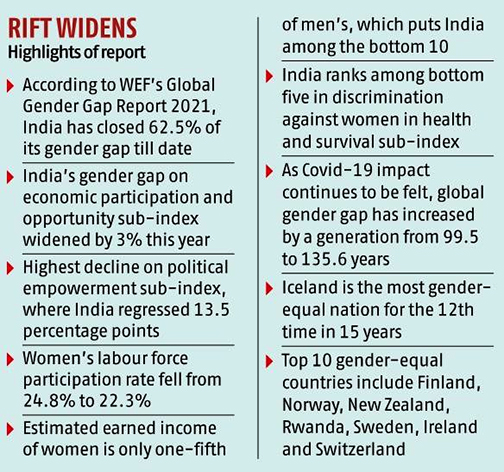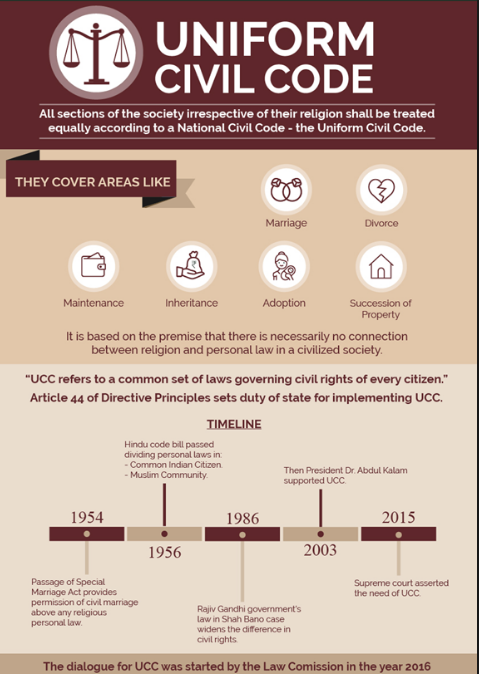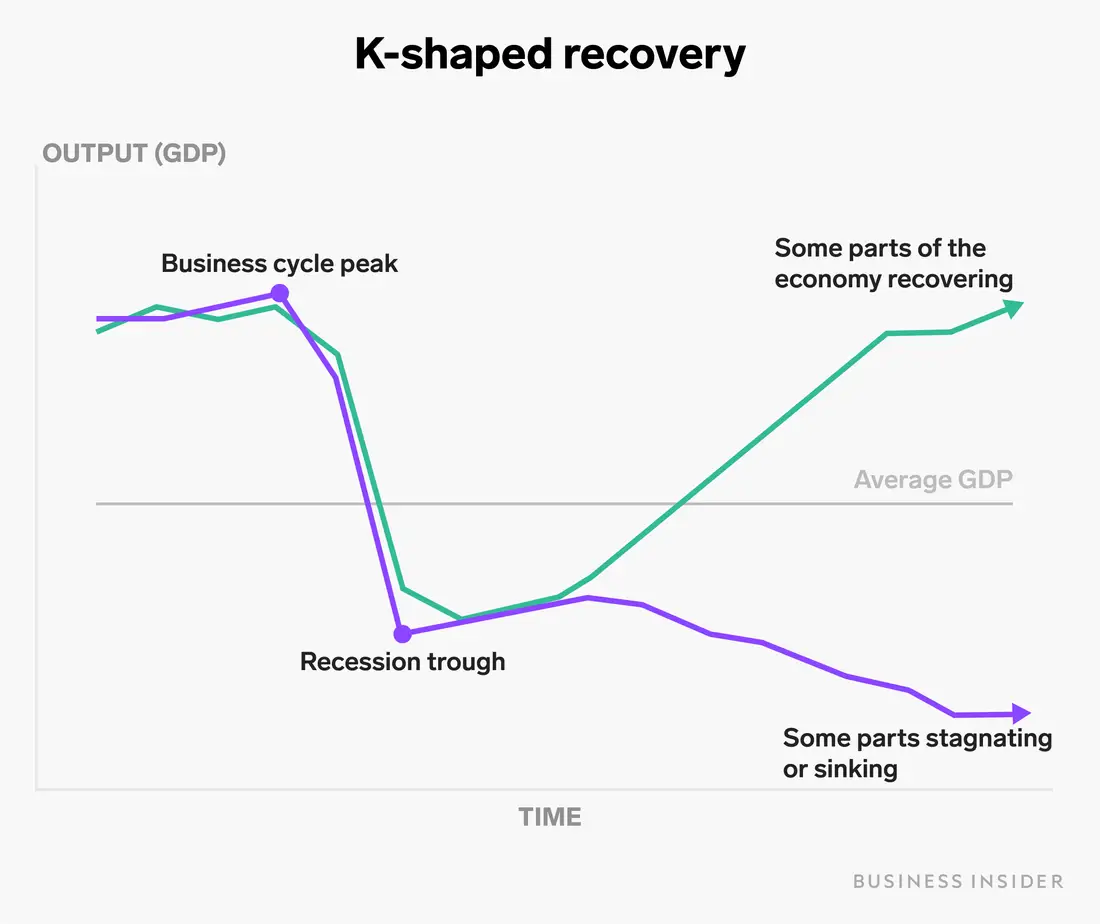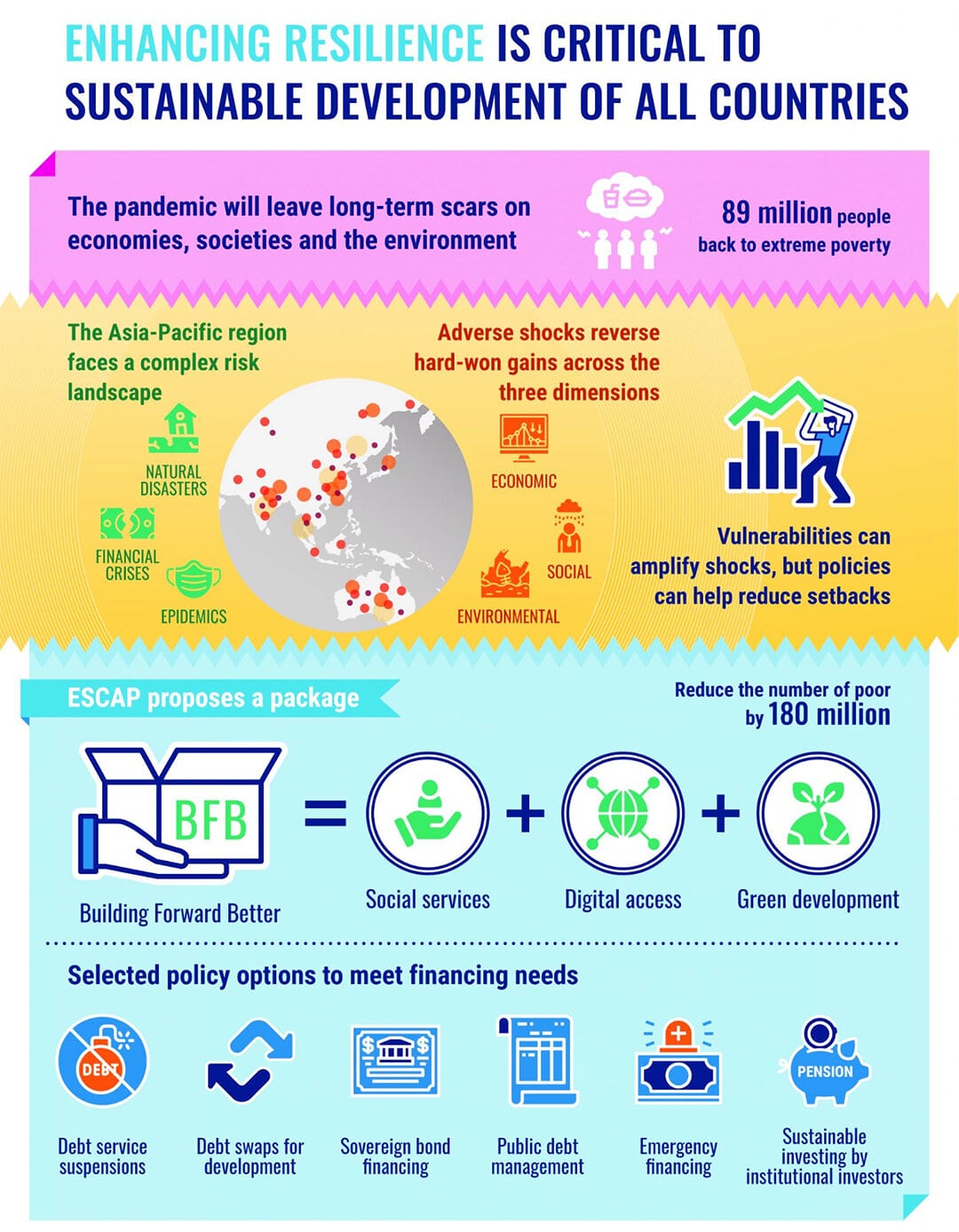Social Justice
Global Gender Gap Report 2021: WEF
Why in News
India has fallen 28 places in the World Economic Forum’s (WEF) Global Gender Gap Report 2021.
- Beti Bachao Beti Padhao, One Stop Centre (OSC) Scheme, Ujjawala Scheme are some the initiatives launched by the government to address the issue of gender inequality.
- Further, the principle of gender equality is enshrined in the Indian Constitution in its Preamble, Fundamental Rights, Fundamental Duties and Directive Principles.
Key Points
- Global Gender Gap Report:
- About:
- It was first published in 2006 by the WEF.
- It benchmarks 156 countries on their progress towards gender parity in four dimensions:
- Economic Participation and Opportunity,
- Educational Attainment,
- Health and Survival and
- Political Empowerment.
- Over the Index, the highest possible score is 1 (equality) and the lowest possible score is 0 (inequality).
- Aim:
- To serve as a compass to track progress on relative gaps between women and men on health, education, economy and politics. Through this annual yardstick, the stakeholders within each country are able to set priorities relevant in each specific economic, political and cultural context.
- About:
- India’s Position:
- Overall Ranking:
- India is now one of the worst performers in South Asia, it is now ranked 140 among 156 countries.
- In South Asia, Bangladesh ranked 65, Nepal 106, Pakistan 153, Afghanistan 156, Bhutan 130 and Sri Lanka 116.
- India had ranked 112th among 153 countries in the Global Gender Gap Index 2020.
- India is now one of the worst performers in South Asia, it is now ranked 140 among 156 countries.
- Political Empowerment:
- India has declined on the political empowerment index as well by 13.5 percentage points, and a decline in the number of women ministers, from 23.1% in 2019 to 9.1% in 2021.
- However, it has still performed relatively well compared to other countries, ranking at 51 in women’s participation in politics.
- Education Attainment:
- In the index of education attainment, India has been ranked at 114.
- Economic Participation:
- The report notes that the economic participation gender gap actually widened in India by 3% this year.
- The share of women in professional and technical roles declined further to 29.2%.
- The share of women in senior and managerial positions also is at 14.6% and only 8.9% firms in the country have top female managers.
- The estimated earned income of women in India is only one-fifth of men’s, which puts the country among the bottom 10 globally on this indicator.
- In Pakistan and Afghanistan, the income of an average woman is below 16% of that of an average man, while in India it is 20.7%.
- Health and Survival index:
- On this India has fared the worst, ranking at 155.
- The only country to have fared worse is China.
- The report points to a skewed sex ratio as the major factor.
- It says the ratio can be attributed to norms of son preference and gender-biased prenatal sex-selective practices.
- China and India together account for about 90 to 95% of the estimated 1.2 to 1.5 million missing female births annually worldwide due to gender-biased prenatal sex selective practices.
- On this India has fared the worst, ranking at 155.
- Overall Ranking:
- Global Scenario:
- Region Wise Rank:
- South Asia incidentally is one of the worst performing regions, followed only by the Middle East and northern Africa.
- Largest Gender Gap in Political Empowerment:
- The gender gap in political empowerment remains the largest: women represent only 26.1% of some 35,500 parliament seats and just 22.6% of over 3,400 ministers worldwide.
- In 81 countries, there has never been a woman head of state, as of 15th January, 2021.
- Bangladesh is the only country where more women have held head-of-state positions than men in the past 50 years.
- Economic Participation:
- The countries with the largest gender gaps in economic participation include Iran, India, Pakistan, Syria, Yemen, Iraq, and Afghanistan.
- Timeframe to Close the Gap:
- It will take South Asia 195.4 years to close the gender gap, while Western Europe will take 52.1 years.
- Region Wise Rank:
World Economic Forum
- The World Economic Forum is the International Organization for Public-Private Cooperation.
- It was established in 1971 as a not-for-profit foundation and is headquartered in Geneva, Switzerland. It is independent, impartial and not tied to any special interests.
- The Forum strives in all its efforts to demonstrate entrepreneurship in the global public interest while upholding the highest standards of governance.
- Some major reports published by WEF are:
- Energy Transition Index.
- Global Competitiveness Report.
- Global IT Report
- WEF along with INSEAD, and Cornell University publishes this report.
- Global Gender Gap Report.
- Global Risk Report.
- Global Travel and Tourism Report.
Social Justice
Human Rights Report 2020: USA
Why in News
The US State Department, in its 2020 Human Rights Report, pointed out several Human Rights Issues in India.
- The report, which is submitted each year to the US Congress, is retrospective and contains a country wise discussion of the state of human rights.
- Earlier in March 2021, Freedom in the World 2021 report had downgraded India’s status from ‘Free’ to ‘Partly Free’.
- India has also been classified as an “electoral autocracy” in the annual report named Autocratisation Goes Viral of Sweden-based Varieties of Democracy (V-Dem) Institute.
Key Points
- Harassment of Journalists:
- The harassment and detention of journalists critical of the (Indian) government in their reporting and on social media, has continued, although the government generally respected the freedom of expression.
- It mentioned restrictions on the press, including violence, threats of violence, or unjustified arrests or prosecutions against journalists.
- Accessing Private Data:
- Government’s requests for user data from Internet companies had increased dramatically.
- The government made 49,382 user data requests in 2019 from Facebook, a 32% increase from 2018. Over the same period, Google requests increased by 69%, while Twitter requests saw a 68% increase.
- Arbitrary Deprivation of Life:
- The report highlighted the case of custodial deaths in Tamil Nadu.
- Unreasonable Detentions:
- The report takes note of the April 2020 detention of protesters against the citizenship laws and various other incidents under the Unlawful Activities Prevention Act 1967.
- Detention of politicians under the Jammu & Kashmir’s Public Safety Act 1978, was also mentioned.
- Improvement in Human Rights Situation in Jammu & Kashmir:
- The government continued taking steps to restore normalcy in Jammu and Kashmir by gradually lifting some security and communications restrictions.
- The government partially restored internet access, however, high-speed 4G mobile internet remained restricted in most parts of Jammu & Kashmir for the year 2020.
- The government continued taking steps to restore normalcy in Jammu and Kashmir by gradually lifting some security and communications restrictions.
- Restrictive Rules and Lack of Investigation:
- Overly restrictive rules on non-governmental organisations, restrictions on political participation, widespread corruption at all levels in the government, lack of investigation of and accountability for violence against women, and forced and compulsory child labour, as well as bonded labour.
- Religious Freedom:
- Tolerance of violations of religious freedom; crimes involving violence and discrimination targeting members of minority groups including women based on religious affiliation or social status.
Human Right Provisions in India
- Enunciated in the Constitution:
- Fundamental Rights: Articles 12 to 35 of the Constitution. These include the Right to Equality, Right to Freedom, Right Against Exploitation, Right to Freedom of Religion, Cultural & Educational Rights, Saving of Certain Laws and Right to Constitutional Remedies.
- Directive Principles of State Policy: Article 36 to 51 of the Constitution. These include 'right to social security, right to work, to free choice of employment, and protection against unemployment, right to equal pay for equal work, right to existence worthy of human dignity, right to free & compulsory education, equal justice & free legal aid and the principles of policy to be followed by the State.'
- Statutory Provisions:
- Protection of Human Rights Act (PHRA), 1993 (as amended in 2019) provided for the constitution of a National Human Rights Commission at the Union level, which steers State Human Rights Commission in States and Human Rights Courts for better protection of Human Rights and for matters connected therewith or incidental thereto.
- Section 2(1)(d) of the PHRA defines Human Rights as the rights relating to life, liberty, equality and dignity of the individual guaranteed by the Constitution or embodied in the International Covenants and enforceable by courts in India.
- Protection of Human Rights Act (PHRA), 1993 (as amended in 2019) provided for the constitution of a National Human Rights Commission at the Union level, which steers State Human Rights Commission in States and Human Rights Courts for better protection of Human Rights and for matters connected therewith or incidental thereto.
- India took active part in drafting of the Universal Declaration of Human Rights (UDHR).
- These 30 rights and freedoms include civil and political rights, like the right to life, liberty, free speech and privacy and economic, social and cultural rights, like the right to social security, health and education, etc.
International Relations
Trade Between India and Pakistan
Why in News
Pakistan will allow the import of cotton and sugar from India, partially reversing a two-year old decision to suspend all trade with India.
- The decision to cancel trade was taken by the Pakistan government in August, 2019, days after the Indian government amended Article 370 and reorganised Jammu and Kashmir.
Key Points
- Pakistan’s Trade Ban:
- Pakistan’s decision to suspend bilateral trade with India in August 2019 was a fallout of the constitutional changes in Jammu and Kashmir.
- However, an underlying reason for suspending trade was the 200% tariff imposed by India on Pakistani imports earlier that year after India revoked Pakistan’s Most Favoured Nation (MFN) status in the aftermath of the Pulwama terrorist attack.
- Trade between the two countries suffered greatly.
- India’s exports to Pakistan dropped nearly 60% to USD 816.62 million, and its imports fell 97% to USD 13.97 million in 2019-20.
- India-Pakistan Trade Before Ban:
- Over the years, India has had a trade surplus with Pakistan, with much less imports than exports and trade has always been linked to politics.
- India’s exports to Pakistan fell around 16% to USD 1.82 billion in 2016-17 as compared to 2015-16 after relations deteriorated in the aftermath of the Uri terror attack and the Indian Army’s surgical strikes on militant launchpads in Pakistan-occupied Kashmir in 2016.
- Despite continuing tensions, trade between the two countries grew marginally in subsequent years.
- Indian exports rose nearly 6% to USD 1.92 billion in 2017-18, and then by around 7% in 2018-19.
- Imports from Pakistan, though much less in volume, also increased by 7.5% to USD 488.56 million in 2017-18 as compared to 2016-17.
- Major Products Traded:
- Pakistan was among India’s top 50 trade partners in 2018-19, but was pushed out of the list in 2019-20.
- It had been anticipated that a trade ban between the countries would affect Pakistan more, since it relied heavily on India for key raw materials for its textiles and pharmaceuticals industries.
- Indian Export to Pakistan:
- In 2018-19, cotton and organic chemicals accounted for around half of Indian export to Pakistan.
- Other major items included plastic, tanning/dyeing extracts, and nuclear reactors, boilers, machinery, and mechanical appliances.
- After the ban, imports of many items fell drastically, while cotton imports stopped altogether.
- The only increase has been in pharmaceutical products. Pakistan has so far imported drug products and organic chemicals to ensure sufficient supplies of medicines during the Covid-19 pandemic.
- Indian Import From Pakistan:
- India’s major imports from Pakistan in 2018-19 were mineral fuels and oils, edible fruits and nuts, salt, sulphur, stone and plastering materials, ores, slag and ash and raw hides and leather.
- Pakistan was among India’s top 50 trade partners in 2018-19, but was pushed out of the list in 2019-20.
- Removal of Trade Ban by Pakistan:
- Shortage in Raw Material: Pakistan decided to lift the ban on cotton imports as there is a shortage in raw material for Pakistan’s textile sector, which has suffered due to low domestic yields of cotton.
- Cheaper Imports from India: Cotton and sugar imports from countries like the USA and Brazil are costlier and take longer to arrive.
- High Domestic Demand and Prices: The decision on sugar was dictated by high demand and high domestic prices.
- The decision to import from India is a measure to stabilize the market prices.
- Implications:
- The decision by Pakistan to allow trade in the selected items will gradually lead to restoration of normalcy in India-Pakistan trade.
- This might be a good time for India to explore a reduction in its 200% import duties on products that its industries can benefit from.
- The move by Pakistan has raised hopes for further measures besides the granting of sports related visas by India after a gap of three years, scheduling a much-delayed meeting of the Indus Water Commissioners in Delhi, peace at the Line of Control (LoC) after more than 5,000 ceasefire violations, as well as the exchange of salutary messages between Indian and Pakistan Prime Ministers.
International Relations
China-Iran Strategic Cooperation Pact
Why in News
China and Iran have signed a 25-year "strategic cooperation pact” which includes "political economic and strategic components".
- The agreement comes amid a major push from China to back Iran to deal with the continuing weight of sanctions reinstated by the US after its withdrawal from the Iranian nuclear deal.
Key Points
- About the Pact:
- It will deepen relations between Iran and China and would establish a blueprint for "reciprocal investments in the fields of transport, ports, energy, industry and services."
- It forms a part of China's trillion-dollar Belt and Road Initiative (BRI), a plan to fund infrastructure projects and increase its influence overseas.
- China's Growing Role in the Middle East:
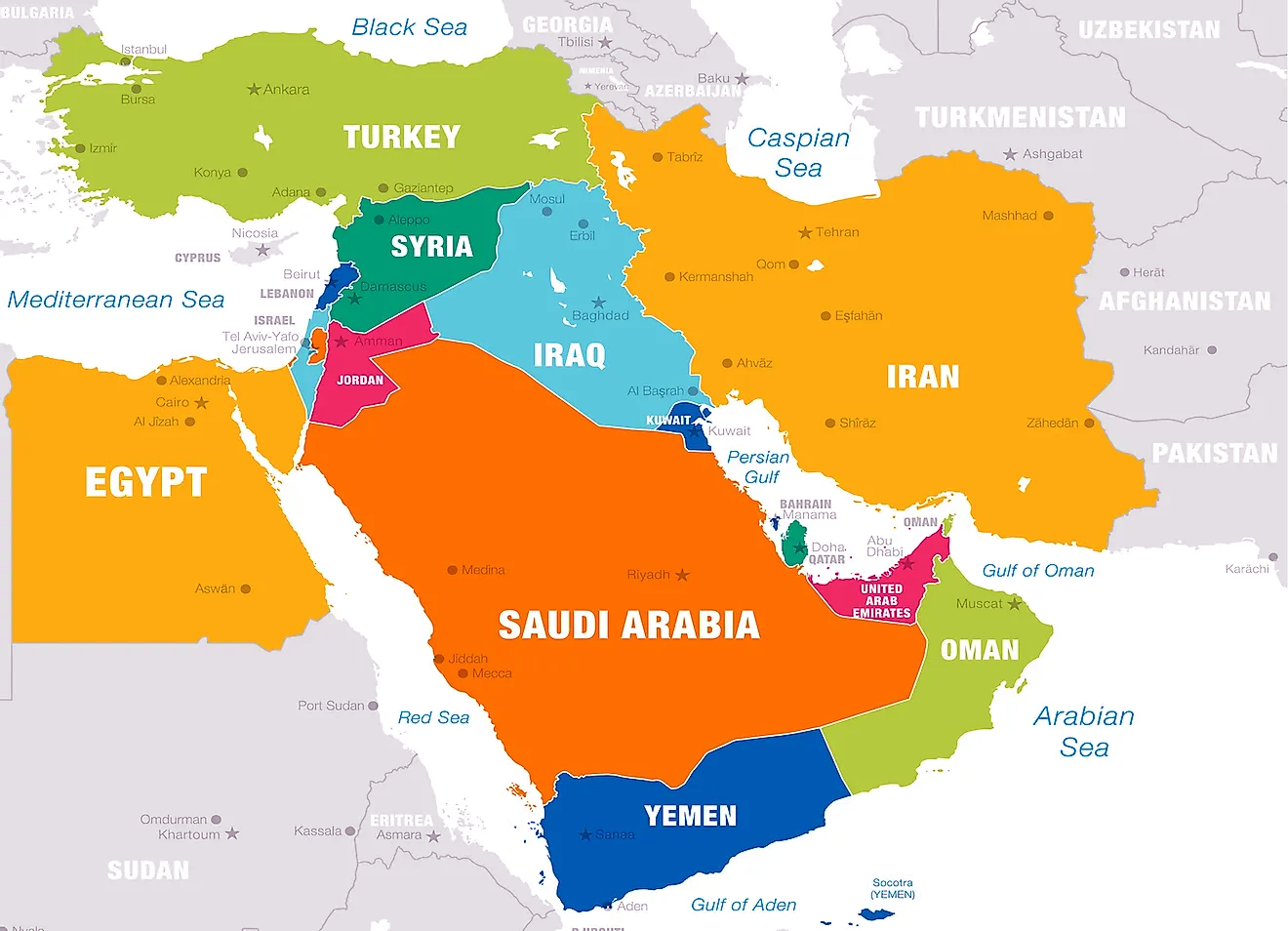
- Iran relies on China as its largest trading partner.
- Chinese foreign minister, in his recent visit to West Asian nations, proposed a five-point initiative for achieving security and stability in the Middle East, advocating "mutual respect, upholding equity and justice, achieving non-proliferation, jointly fostering collective security, and accelerating development cooperation.”
- Earlier, China and Russia called for the US to unconditionally return to the Joint Comprehensive Plan of Action (JCPOA) as soon as possible and revoke the unilateral sanctions against Iran.
- In this context, they proposed "the establishment of a regional security dialogue platform to converge a new consensus on resolving the security concerns of countries in the region.”
- India's Concerns:
- Military Partnership: China is also concluding a security and military partnership with Iran.
- China calls for “joint training and exercises, joint research and weapons development and intelligence sharing” to fight “the lopsided battle with terrorism, drug and human trafficking and cross-border crimes”.
- The sizable Chinese investments in Iranian ports development may eventually be turned into permanent military access arrangements with Iran.
- Strategic Stakes Around the Chabahar Port: With a growing Chinese presence in Iran, India is concerned about its strategic stakes around the Chabahar port project that it has been developing.
- The port is close to Gwadar port in Pakistan, which is being developed by China as part of its China-Pakistan Economic Corridor that links it to the Indian Ocean through BRI.
- Geopolitical Rivalry: India finds itself caught in the geopolitical rivalry between the US & China over Iran.
- India’s dilemma also stems from the fact that robust support from the US is essential when it is locked in a border stand-off with China.
- Impact on Relationship with Other Countries: Growing Chinese footsteps in Iran will have a long-lasting impact on India’s relationship with not only Iran but also on Afghanistan and Central Asian nations.
- Military Partnership: China is also concluding a security and military partnership with Iran.
Joint Comprehensive Plan of Action
- In 2015, Iran with the P5+1 group of world powers - the USA, UK, France, China, Russia, and Germany agreed on a long-term deal on its nuclear programme.
- The deal was named as Joint Comprehensive Plan of Action (JCPOA) and in common parlance as Iran Nuclear Deal.
- Under the deal, Iran agreed to curb its nuclear activity in return for the lifting of sanctions and access to global trade.
- The agreement allowed Iran to accumulate small amounts of uranium for research but it banned the enrichment of uranium, which is used to make reactor fuel and nuclear weapons.
- Iran was also required to redesign a heavy-water reactor being built, whose spent fuel could contain plutonium suitable for a bomb and to allow international inspections.
- In 2018, the United States declared its withdrawal from JCPOA and imposed unilateral sanction on Iran.
- Iran has pulled away from restrictions imposed under the deal in order to put pressure on the other signatories — Germany, France, Britain, Russia and China — to provide new economic incentives to offset US sanctions.
Indian Polity
Uniform Civil Code
Why in News
Recently, a petition has been filed in Supreme Court against Uniform Civil Code (UCC) on divorce and alimony.
Key Points
- About:
- UCC is one that would provide for one law for the entire country, applicable to all religious communities in their personal matters such as marriage, divorce, inheritance, adoption etc.
- Article 44 of the Constitution lays down that the state shall endeavour to secure a UCC for the citizens throughout the territory of India.
- Article 44 is one of the Directive Principles of State Policy (DPSP).
- DPSP as defined in Article 37, are not justiciable (not enforceable by any court) but the principles laid down therein are fundamental in governance.
- Status of Uniform Codes in India:
- Indian laws do follow a uniform code in most civil matters such as Indian Contract Act 1872, Civil Procedure Code, Transfer of Property Act 1882, Partnership Act 1932, Evidence Act, 1872 etc.
- States, however, have made hundreds of amendments and, therefore, in certain matters, there is diversity even under these secular civil laws.
- Recently, several states refused to be governed by the uniform Motor Vehicles Act, 2019.
- Background:
- The origin of the UCC dates back to colonial India when the British government submitted its report in 1835 stressing the need for uniformity in the codification of Indian law relating to crimes, evidence, and contracts, specifically recommending that personal laws of Hindus and Muslims be kept outside such codification.
- Increase in legislations dealing with personal issues in the far end of the British rule forced the government to form the B N Rau Committee to codify Hindu law in 1941.
- Based on these recommendations, a bill was then adopted in 1956 as the Hindu Succession Act to amend and codify the law relating to intestate or unwilled succession, among Hindus, Buddhists, Jains, and Sikhs.
- However, there were separate personal laws for muslim, chirstian and Parsis.
- In order to bring uniformity, the courts have often said in their judgements that the government should move towards a UCC.
- The judgement in the Shah Bano case (1985) is well known.
- Another case was the Sarla Mudgal Case (1995), which dealt with issue of bigamy and conflict between the personal laws existing on matters of marriage.
- By arguing that practices such as triple talaq and polygamy impact adversely the right of a woman to a life of dignity, the Centre has raised the question whether constitutional protection given to religious practices should extend even to those that are not in compliance with fundamental rights.
- Implications of Uniform Civil Code on Personal Laws:
- Protection to Vulnerable Section of Society:
- The UCC aims to provide protection to vulnerable sections as envisaged by Ambedkar including women and religious minorities, while also promoting nationalistic fervour through unity.
- Simplification of Laws:
- The code will simplify the complex laws around marriage ceremonies, inheritance, succession, adoptions making them one for all. The same civil law will then be applicable to all citizens irrespective of their faith.
- Adhering to Ideal of Secularism:
- Secularism is the objective enshrined in the Preamble, a secular republic needs a common law for all citizens rather than differentiated rules based on religious practices.
- Gender Justice:
- If a UCC is enacted, all personal laws will cease to exist. It will do away with gender biases in existing laws.
- Protection to Vulnerable Section of Society:
- Challenges:
- Exceptions in Central Family Laws:
- The preliminary sections in all central family law Acts enacted by Parliament since Independence declare that they will apply to “the whole of India except the state of Jammu and Kashmir.”
- A Second exception was added in 1968 in all these Acts, pronouncing that “nothing herein contained shall apply to the Renoncants in the Union Territory of Pondicherry.”
- A third exception, none of these Acts applies in Goa, Daman and Diu.
- A fourth exception, relating to the north-eastern states of Nagaland and Mizoram, emanates from Articles 371A and 371G of the Constitution, decreeing that no parliamentary legislation will replace the customary law and religion-based system for its administration.
- The preliminary sections in all central family law Acts enacted by Parliament since Independence declare that they will apply to “the whole of India except the state of Jammu and Kashmir.”
- Communal Politics:
- The demand for a uniform civil code has been framed in the context of communal politics.
- A large section of society sees it as majoritarianism under the garb of social reform.
- Constitutional Hurdle:
- Article 25 of Indian constitution, that seeks to preserve the freedom to practise and propagate any religion gets into conflict with the concepts of equality enshrined under Article 14 of indian Constitution.
- Exceptions in Central Family Laws:
Way Forward
- The government and society will have to work hard to build trust, but more importantly, make common cause with social reformers rather than religious conservatives.
- Rather than an omnibus approach, the government could bring separate aspects such as marriage, adoption, succession and maintenance into a UCC in stages.
- Need of the hour is the codification of all personal laws so that prejudices and stereotypes in every one of them would come to light and can be tested on the anvil of fundamental rights of the Constitution.
Indian Economy
4% Inflation Target Retained by Government
Why in News
The Government of India has decided to retain the inflation target of 4%, with a tolerance band of +/- 2 percentage points for the Monetary Policy Committee of the Reserve Bank of India (RBI) for the coming five years.
- Earlier, the RBI in its Currency and Finance (RCF) report for the year 2020-21 also recommended the inflation target to be kept same as 4% +/-2% for next 5 years.
Key Points
- About:
- To control the price rise, the Centre in 2016 gave a mandate to the RBI to keep the retail inflation at 4% with a margin of 2% on either side for a five-year period ending 31st March, 2021.
- The Consumer Price Index (CPI) tracks the change in retail prices of goods and services which households purchase for their daily consumption.
- The inflation target for the period 1st April, 2021 to 31st March, 2026 under the Reserve Bank of India Act 1934 has been kept at the same level as was for previous 5 years.
- To control the price rise, the Centre in 2016 gave a mandate to the RBI to keep the retail inflation at 4% with a margin of 2% on either side for a five-year period ending 31st March, 2021.
- Background:
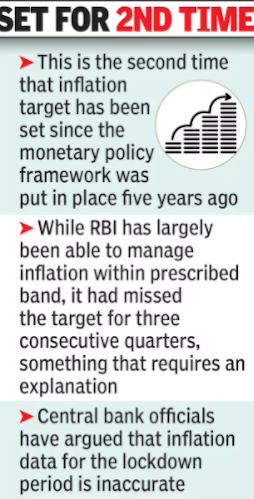
- The central bank and the government agreed in 2015 on a policy framework that stipulated a primary objective of ensuring price stability while keeping in mind the objective of growth.
- The Flexible Inflation Target (FIT) was adopted in 2016. The Reserve Bank of India Act, 1934 was amended to provide a statutory basis for a FTI framework.
- The amended Act provides for the inflation target to be set by the Government, in consultation with the RBI, once every five years.
- Inflation Targeting:
- It is a central banking policy that revolves around adjusting monetary policy to achieve a specified annual rate of inflation.
- Inflation targeting is known to bring more stability, predictability, and transparency in deciding monetary policy.
- Strict Inflation Targeting:
- It is adopted when the central bank is only concerned about keeping inflation as close to a given inflation target as possible, and nothing else.
- Flexible Inflation Targeting:
- It is adopted when the central bank is to some extent also concerned about other things, for instance, the stability of interest rates, exchange rates, output and employment.
Monetary Policy
- It is the macroeconomic policy laid down by the central bank. It involves management of money supply and interest rate and is the demand side economic policy used by the government of a country to achieve macroeconomic objectives like inflation, consumption, growth and liquidity.
- In India, monetary policy of the Reserve Bank of India is aimed at managing the quantity of money in order to meet the requirements of different sectors of the economy and to increase the pace of economic growth.
- The RBI implements the monetary policy through open market operations, bank rate policy, reserve system, credit control policy, moral persuasion and through many other instruments.
Monetary Policy Committee
- It is a statutory and institutionalized framework under the Reserve Bank of India Act, 1934, for maintaining price stability, while keeping in mind the objective of growth.
- The Governor of RBI is ex-officio Chairman of the committee.
- The MPC determines the policy interest rate (repo rate) required to achieve the inflation target (4%).
- An RBI-appointed committee led by the then deputy governor Urjit Patel in 2014 recommended the establishment of the Monetary Policy Committee.
Indian Economy
Economic and Social Survey of Asia and the Pacific 2021: UNESCAP
Why in News
A report ‘Economic and Social Survey of Asia and the Pacific 2021: Towards post-Covid-19 resilient economies’ has recently been released by the United Nations Economic and Social Commission for Asia and the Pacific (UNESCAP).
- According to the report, India is estimated to record an economic growth of 7% in 2021-22, over a contraction of 7.7% witnessed in the previous fiscal on account of the pandemic’s impact on normal business activity.
Key Points
- Other Observation Regarding India:
- India’s 2021 economic output, however, is expected to remain below the 2019 level despite a robust reduction in new Covid-19 cases and the start of vaccine roll-out.
- India entered the pandemic with already subdued GDP (Gross Domestic Product) growth and investment.
- Moreover, one of the most stringent lockdowns in the world caused the severe economic disruptions that the country experienced in the year 2020.
- A subsequent change in lockdown policies and success in reducing infection rates supported an impressive economic turnaround in the later months of 2020.
- Challenges: The report mentions two major challenges for India on its path to faster recovery.
- Maintaining low borrowing costs, and
- Keeping non-performing loans in check.
- Observation Regarding Asia Pacific Countries:
- The socio-economic impact of the Covid-19 pandemic was amplified due to lack of resilience and investments in people and the planet.
- China’s swift and effective response to Covid-19 enabled it to become the only major economy worldwide to achieve a positive annual economic growth rate in 2020.
- On an average, developing Asia-Pacific economies are expected to grow 5.9% in 2021 and 5% in 2022.
- The prospect of a K-shaped recovery, characterized by uneven post-pandemic recovery across countries and widened inequality gaps within countries, is highlighted as a primary policy challenge.
K-Shaped Recovery
- A K-shaped recovery occurs when, following a recession, different parts of the economy recover at different rates, times, or magnitudes. This is in contrast to an even, uniform recovery across sectors, industries, or groups of people.
- A K-shaped recovery leads to changes in the structure of the economy or the broader society as economic outcomes and relations are fundamentally changed before and after the recession.
- This type of recovery is called K-shaped because the path of different parts of the economy when charted together may diverge, resembling the two arms of the Roman letter "K."
- Suggestions:
- For a more robust and inclusive recovery, the report calls for a more synchronised Covid-19 vaccination programme across countries. There is a need to leverage regional cooperation.
- It recommends that fiscal and monetary support should be sustained, as premature tightening could increase long-term scars.
- Continuity in policy support is a must and recovery policy packages should focus on building resilience and investing in the 2030 Agenda for Sustainable Development.
- To deal with various economic and non-economic shocks, a more integrated risk management approach to planning and policymaking is needed.
Economic and Social Survey of Asia and the Pacific
- Produced annually since 1947, the Economic and Social Survey of Asia and the Pacific is the oldest United Nations report on the region’s progress.
- The Survey monitors regional progress, provides cutting-edge analyses and guides policy discussion on the current and emerging socio-economic issues and policy challenges to support inclusive and sustainable development in the region.
- Since 1957, the Survey has also contained a study or studies focusing on a significant aspect or challenge relevant to the economies of the Asia-Pacific region.
- The Survey of 2021 studies the impact of Covid-19 pandemic and provides insights for post-Covid-19 resilient economies.
United Nations Economic and Social Commission for Asia and the Pacific
- The United Nations Economic and Social Commission for Asia and the Pacific (UNESCAP) is the regional development arm of the United Nations for the Asia-Pacific region.
- It has 53 Member States and 9 Associate Members from Asia-Pacific Region including India.
- Established: 1947
- Headquarters: Bangkok, Thailand
- Objective: To overcome some of the region’s greatest challenges by providing results-oriented projects, technical assistance and capacity building to member States.

